BRUM BEAT REVIEWS
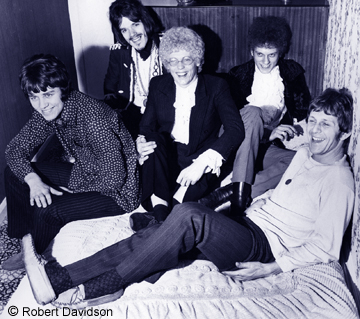
Hearing the grass grow...
THE MOVE REMASTERED
The year 2007 was an incredibly good one for fans of Birmingham's legendary group The Move. It was a year that marked the 40th anniversary of the band's first 1960s chart success with a handful of hit singles that placed them at the cutting edge of innovative pop music as that decade reached its creative peak.
2007 was also the year of the group's first official re-union with a series of well-received concerts in the U.K. October also saw the high-quality re-issue of The Move's original 1960s albums on CD as part of the definitive collection documenting their recorded legacy.
OKAY... I admit it, I LOVE this band! So if you're expecting an un-biased review of the excellent Move 40th Anniversary Remaster Series of CDs then you can stop reading NOW! Seriously though, fans of the band - and there's a lot of them - have waited a long time for this collection that has seen a long time in preparation. A big thank you goes out to ELO archivist Rob Caiger who has spent the last several years tracking down the master tapes to these recordings and thus considerably improving on audio quality while at the same time recovering some long-lost and forgotten Move tracks that have never seen the light of day until now.
Many higher-profile groups have yet to get similar high-quality treatment in their re-issues as have been accomplished with those of The Move and ELO With an effort that often reads like a detective story, Rob recovered the multi-track session tapes and mono master tapes for The Move's self-titled debut album and the stereo master tapes for its follow-up 'Shazam' - which had been lost since the 1970s. One box of tapes was even found in a forgotten London tape-vault along with some previously unknown David Bowie recordings! This definitive Move collection is simply the best that has ever been available of one of the most critically acclaimed and successful Brum bands of the 1960s.
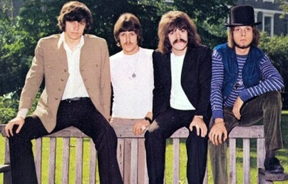
The group themselves have often said they were not happy with the original production of some of their early records with many failing to capture the energy the band was famous for on-stage. While being sympathetic to the original mono production as used on many early tracks, albeit with improved audio quality, the re-masters include bonus re-mixed stereo versions of some tracks along with two previously un-released original songs. It is important to note also, these re-mastered Move recordings contain the full-length original versions as compared to many previous re-issues on vinyl or CD that were annoyingly cut short by premature fade-outs.
Hearing these re-mastered for CD recordings for the first time (especially those on the bonus 'New Movement' disc) will cause surprise to those who are already familiar with The Move's records. The clarity of sound is amazing! The "flatness" that characterized previous re-issues has been replaced by clearly distinguished layers that cause vocals and instruments previously buried in the mix to be clearly heard for the first time. Keep in mind that these records were originally meant to be played on AM radio and low-fidelity turntables that were unable to reproduce the spectrum of sound we have come to expect from the Compact Disc format.
These new MOVE releases on the SALVO/FLY Records label will in all probability become collectors items themselves as interest in the group and indeed any influential pop/psychedelic music from the 1960s continues to grow. The following is a description of each album package with a complete track-listing.
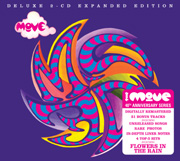
THE MOVE (SALVODCD207)
The first CD of the remastered 1968 Move album package restores their debut album back to its full mono glory while also including the band's 1966 to 1968 singles as well as their B-sides. This - the Move's first (self-titled) album - was recorded sporadically from October 1966 through to February 1968 whenever the band was able to take time out from their busy schedule of appearances. Two of the album's tracks, 'Flowers In The Rain' and 'Fire Brigade' had already seen single release reaching Number 2 and 3 in the U.K. charts respectively.
This album, recorded at Advision Sound, Olympic, and De Lane Lea Studios in London, was not issued until spring 1968 by which time some of the tracks were more than a year old although four hit singles and B-sides from the same sessions had already been released by then. As such, the debut Move album appeared more like a record of the band from the previous year who had by now started to "move" in a new musical direction following the departure of their enigmatic bass guitarist Ace Kefford. Still, this album stands today as a great collection of vintage British pop/psychedelic tracks - mostly brilliant originals composed by Roy Wood and recorded by the first "classic" line-up of The Move that featured Carl Wayne, Roy Wood, Trevor Burton, Ace Kefford and Bev Bevan.
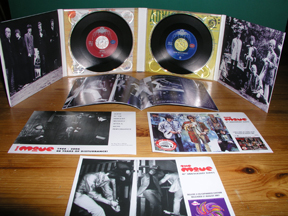
The 'New Movement' disc, included as a bonus with the re-mastered mono edition of the first Move album, will be of special interest to Move fans. The disc contains previously unissued stereo mixes of early singles and album tracks as well as previously unreleased songs and alternate versions. Rob Caiger explains the process involved in producing these recordings as follows;
"We tried to stay true to the original recording process and work with what was on the tapes (while also bearing in mind what was originally buried in the mono mix was now being revealed in stereo). We were also conscious that these songs were not going to be listened to in the format they were originally recorded for - a vinyl LP through a mono or rudimentary stereo speaker system in 1968 - a consideration also applied to CD 1 when remastering the original mono master tapes.
Though we were able to create (mostly) separated 8-12-track individual channels of music, from the original 4-track multitracks, sometimes we couldn't separate out all the individual instruments or vocals from some of the tracks. And then there were bits of music missing, some obvious, some less so. There were instances when two or more instruments existed only as a single mix on 1 channel (or were recorded together in the studio - drums, bass and a rhythm guitar - as 1 rhythm track).
There were times when individual instruments couldn't be mixed together by us as good as or better than the original mixed "bounces" (see below) or there was an effect applied to one of the instruments/vocals that couldn't be matched. We then had to leave the original bounced mix, for say drums, bass, rhythm guitar on 1 track (or a section of vocal harmonies) and mix the remaining tracks around that. Or try something else... All I can say is that I'm glad for - and in awe of - the incredible sonic wizzardry of Church Walk Studios engineer and producer Rob Keyloch for conjuring all his brilliant mixes!
Just to explain, the original 4-track multitrack tapes contained music recorded onto four individual channels. All, or some of these channels were then mixed together to another tape and "bounced" back to one track of the original session tape, which then freed up the remaining three tracks so more music could be recorded. And so on, until the song was complete. The final 4-track session tape was then mixed or "reduced" down to a mono, single track master. The record company would then copy this tape to make their own production master tape from which the vinyl LP would be eventually pressed.
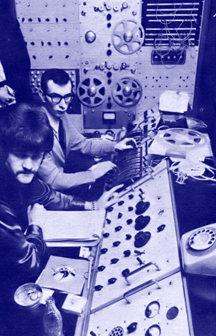
Denny Cordell (the Move's original producer) did some wonderful work in the mono format but one criticism of his and other producers from the period was that the music sounded "thin", especially the drums. To the listener, especially those listening to the music through transistor radios (which many of the mixes were done deliberately for - and which don't hold up when transferred to the digital format and played back through today's hi-fi systems) this was THE sound of the record - and is what many of us grew up listening to and remember.
It might not be what the band sounded like - and many fans got a shock when they heard The Move live - as did the band sometimes when they heard their records - but it was the sound we knew and why so many fans get upset (or pleased!) when these cherished songs get the remaster and remix treatment years later. Mono records certainly had their own specific sound but arguably, it was the sound of the record, the producer and/or the radio and the limitations of the recording techniques of the period - as opposed to what the band really sounded like in the studio and on-stage. In many cases though, it was the producer and the recorded sound that MADE the record - not the band. Phil Spector is probably the best example. For The Move, these new stereo remixes try to present another side from what has gone before and hopefully get us all a little closer to their "actual" sound.
Some parts were absent - the bounce tapes and some masters were missing. The horn parts of 'Cherry Blossom Clinic' were nowhere to be found and in all probability, the tape had been used again and the horn parts recorded over - tape was expensive back then! Also, what was originally recorded wasn't in the best technical condition on some of the tapes so a lot of the levels couldn't be pushed up too high or instrumentation brought out too much because flaws would have been revealed. I remember on some songs there was distortion on some of the vocals, guitars and added effects.
It's not perfect but I think it's the best we could do with the condition of the tapes and the limitations of the original recording process. A huge amount of the credit for the superb final sound is due to the remastering genius of Nick Robbins at Sound Mastering. And the band likes it, as does Tony Visconti, so that has to be a good thing!"
The above comments edited by Rob Caiger were first published in their original format on the Official Move Mailing List copyright © Lynn Hoskins - see www.eskimo.com/~noanswer/movelist.html
Best of all, the 'New Movement' disc contains two original Move songs that are released here for the first time. These previously forgotten tracks, both composed by Roy Wood, were never issued because of technical problems (now resolved) encountered at the time. The first song simply titled 'Move' is an incredibly up-beat number with a lead vocal by Carl Wayne and the fantastic four-part harmonies the band was famous for. In addition, Bev Bevan contributes some of the best machine-gun like drumming ever heard on a Move track. Recorded in January of 1967 and planned as the B-side to their second single, 'Move' is a real undiscovered treasure that will delight any Move fan.
The second previously unreleased song called 'Don't Throw Stones At Me', also from January 1967, features a rare Ace Kefford lead vocal. Though Ace featured prominently in The Move's live performances and had his turn singing a lead line or two on some of The Move's recordings, his voice was usually limited to the high harmonies on many of the groups songs. In this case he does a fantastic job on this Roy Wood original that sounds as fresh now as on the day it was recorded. Roy also contributes one of his typically characteristic guitar solos to this one. New Movement even has an alternate recording of the group's proto-punk rocker 'Vote For Me' - the rarest of all Move B-sides.
The complete track listing for The Move's 1968 debut album re-mastered CD (with bonus material) and the 'New Movement' CD that comes packaged with it is as follows:
CD 1 'Move' (original mono Regal Zonophone album LRZ 1002):
| 1 | Yellow Rainbow (Roy Wood) lead vocal by Trevor Burton |
| 2 | Kilroy Was Here (Roy Wood) lead vocal by Roy with Trevor |
| 3 | (Here We Go Round) The Lemon Tree (Roy Wood) lead vocal by Roy with Trevor |
| 4 | Weekend (cover of Eddie Cochrane song) with lead vocal by Trevor Burton |
| 5 | Walk Upon The Water (Roy Wood) lead vocal by Carl Wayne with Trevor & Roy |
| 6 | Flowers In The Rain (Roy Wood) the Move's third single A-side with lead vocal by Carl and Roy (No. 2 chart hit) |
| 7 | Hey Grandma (cover of Moby Grape song) with lead vocal by Carl & Trevor |
| 8 | Useless Information (Roy Wood) lead vocal by Carl & Roy |
| 9 | Zing Went The Strings Of My Heart (cover of The Coasters hit) with lead vocal by Bev Bevan and Ace Kefford |
| 10 | The Girl Outside (Roy Wood) lead vocal by Trevor Burton |
| 11 | Fire Brigade (Roy Wood) single A-side with lead vocal by Roy & Carl (No. 3 chart hit) |
| 12 | Mist On A Monday Morning (Roy Wood) lead vocal by Roy |
| 13 | Cherry Blossom Clinic (Roy Wood) lead vocal by Trevor & Roy |
| Bonus tracks (mono - original singles A & B sides) | |
| 14 | Vote For Me (Roy Wood) rare B-side to the cancelled 'Cherry Blossom Clinic' single with lead vocal by Trevor Burton with Roy |
| 15 | Disturbance (Roy Wood) B-side to 'Night Of Fear' single with lead vocal by Carl, Roy & Ace |
| 16 | Night Of Fear (Roy Wood) the Move's first single with lead vocal by Carl & Roy with Ace & Trevor (No. 2 chart hit) |
| 17 | Wave The Flag And Stop The Train (Roy Wood) B-side to 'I Can Hear The Grass Grow' single with lead vocal by Carl Wayne with Trevor, Roy & Ace |
| 18 | I Can Hear The Grass Grow (Roy Wood) the Move's second single (No. 5 chart position) with lead vocal by Carl, Roy & Ace with Trevor & Bev |
CD 2 'New Movement' (stereo & previously unreleased):
| 1 | Move Intro (Roy Wood) previously unreleased with group vocal-only intro by Carl, Roy, Trevor & Ace |
| 2 | Move (Roy Wood) previously unreleased song with lead vocal by Carl Wayne |
| 3 | Cherry Blossom Clinic (Roy Wood) 2007 stereo mix |
| 4 | Fire Brigade (Roy Wood) 2007 stereo mix |
| 5 | Kilroy Was Here (Roy Wood) 2007 stereo mix |
| 6 | (Here We Go Round) The Lemon Tree (Roy Wood) 2007 stereo mix |
| 7 | Weekend 2007 stereo mix of the Eddie Cochrane song as sung by Trevor Burton |
| 8 | Zing Went The Strings Of My Heart 2007 stereo mix of the Coasters cover sung by Beve Bevan and Ace Kefford |
| 9 | Don't Throw Stones At Me (Roy Wood) previously unreleased song with lead vocal by Ace Kefford |
| 10 | Mist On A Monday Morning (Roy Wood) 2007 stereo mix |
| 11 | Vote For Me (Roy Wood) previously unreleased alternate take |
| 12 | Night Of Fear (Roy Wood) 2007 stereo mix |
| 13 | The Girl Outside (Roy Wood) alternate take in original stereo from the 1968 Regal Zonophone mono/stereo hybrid album SLRZ 1002 |
| 14 | Walk Upon The Water (Roy Wood) original stereo mix from the 1968 Regal Zonophone mono/stereo hybrid album SLRZ 1002 |
| 15 | Useless Information (Roy Wood) original stereo mix from the 1968 Regal Zonophone mono/stereo hybrid album SLRZ 1002 |
| 16 | Flowers In The Rain (Roy Wood) 2007 stereo mix |

SHAZAM (SALVOCD012)
The recording sessions for the second Move album titled 'Shazam' had begun during the summer of 1969 although the album was not completed until after the Move's tour of the USA in October of that year. Prior to the sessions for this album, the group had seen the departure of original members Ace Kefford and Trevor Burton along with the new addition of Rick Price from the Brum band Sight and Sound.
Shazam is probably the most familiar of all The Move's original albums to the North American audience. It was their first non-import to be released there and even got some air-play on the more progressive FM radio stations. Originally envisioned as a double-album, Shazam contained only six tracks although these were much longer in length than those on the first Move album. Most of the songs on Shazam were performed live by the group during their short 1969 tour of the USA.
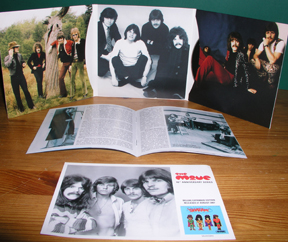
The three songs on side one of Shazam were composed by Roy Wood while those on side two were covers. Although none of the songs from Shazam appeared on singles by the Move, the Roy Wood composition 'Hello Susie' was recorded by the UK band Amen Corner who got to number four in the charts with it. Shazam was the last Move record that Carl Wayne appeared on as he left the group just before its release in February of 1970.
Of particular note, most of the tracks on Shazam feature a spoken word introduction by Carl Wayne and a member of the unwary public who happened to be passing by outside of the recording studio at the time and whose comments were recorded on tape by the band. The album has a great almost 8-minute long re-working of Roy Wood's 'Cherry Blossom Clinic' that starts with a very Brummie intro. This amazing track includes a long instrumental break of guitar and bass featuring excerpts from Bach's 'Ode To Joy' with 'The Sorcerer's Apprentice' - you've got to hear this one to believe it!
For me though, the highlight of the Shazam album are Carl Wayne's fantastic vocal performances. His incredible range goes from Roy Wood's perfect composition 'Beautiful Daughter' to the intense blues-wailing 'Don't Make My Baby Blue' followed by my personal favourite 'The Last Thing On My Mind' with whom Carl in turn shares lead vocal with Roy and Rick. Lyrically in retrospect, this one sounds like something of a tribute to Carl and in my opinion, the best non-original song they ever recorded.
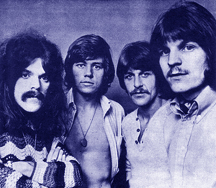
In addition to improved sound quality, the re-mastered Shazam album, now as per the original vinyl release, has the "false-start" at the beginning of the track 'Don't Make My Baby Blue' re-instated after annoyingly being removed on the previous CD versions. The re-master also includes no less than eight bonus tracks consisting of non-album singles & B-sides as well as demo versions and alternate mixes.
Bonus tracks on this CD include the singles A & B-sides 'Wild Tiger Woman/Omnibus', 'Blackberry Way/That Certain Something' (the only Move single to reach Number One in the charts), and 'Curly/This Time Tomorrow'. With the exception of the 'Curly' single, these A & B-sides were recorded with the line-up of Carl Wayne, Roy Wood, Trevor Burton and Bev Bevan after the departure of Ace Kefford from the group. Curly was recorded with Rick Price after the departure of Trevor Burton.
Included with the bonus tracks is a great previously unreleased demo-version of Dave Morgan's 'That Certain Something' done in a very bluesy style - quite unlike the released-version. This one has future ELO members Richard Tandy on bass and Dave Morgan on rhythm guitar with future Wizzard drummer Keith Smart and Trevor Burton playing lead. The demo of 'This Time Tomorrow' has a Carl Wayne vocal instead of Rick Price who did the official version. The Shazam album artwork was an original painting of the group by Mike Sheridan (of The Nightriders).
CD 'Shazam' (original stereo Regal Zonophone album SLRZ 1012):
| 1 | Hello Susie (Roy Wood) lead vocal by Roy |
| 2 | Beautiful Daughter (Roy Wood) lead vocal by Carl Wayne |
| 3 | Cherry Blossom Clinic Revisited (Roy Wood) lead vocal by Carl Wayne |
| 4 | Fields Of People cover of Ars Nova song with lead vocal by Carl Wayne |
| 5 | Don't Make My Baby Blue (Barry Mann & Cynthia Weil) lead vocal by Carl Wayne |
| 6 | The Last Thing On My Mind (Carl Paxton) lead vocal by Carl Wayne, Roy Wood and Rick Price |
| Bonus tracks (original singles A & B sides plus stereo & demo versions) | |
| 7 | This Time Tomorrow (Dave Morgan) the B-side to the 1969 'Curly' single with lead vocal by Rick Price |
| 8 | That Certain Something (Roy Wood) 2007 stereo mix and B-side to 1969 'Blackberry Way' single with lead vocal by Carl Wayne |
| 9 | Curly (Roy Wood) 1968 single A-side with lead vocal by Roy & Carl Wayne (No. 12 chart hit) |
| 10 | Wild Tiger Woman (Roy Wood) 2007 stereo mix of 1968 single A-side with lead vocal by Carl, Roy & Trevor |
| 11 | Omnibus (Roy Wood) previously unreleased full-length 2007 stereo mix. The B-side to 'Curly' single with lead vocal by Carl & Roy |
| 12 | That Certain Something (Dave Morgan) previously unreleased demo version |
| 13 | This Time Tommorow (Dave Morgan) previously unreleased demo version |
| 14 | Blackberry Way (Roy Wood) alternate mix single A-side (No. 1 chart position) with lead vocal by Roy |
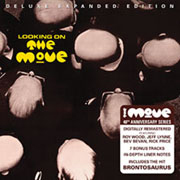
LOOKING ON (SALVOCD014)
The latest remaster of this series is the Move's 'Looking On' album from 1970. It's the last of the original Move albums to get the re-master treatment although chronologically, their final LP 'Message From The Country' was already brilliantly re-issued in 2005. Apparently, Looking On received very little promotion at the time of its original release as the band had switched to the new Harvest Records label with Fly Records then concentrating their resources to promote Marc Bolan & Tyrannosaurus Rex.
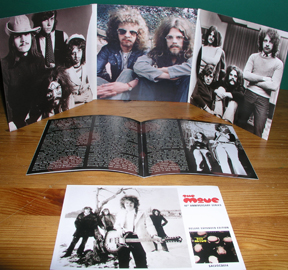
I had always thought of 'Looking On' as the Move's "forgotten" album but in the big scheme of things it may be their most significant as it was the first album to be recorded by the line-up that (minus Rick Price) would become the Electric Light Orchestra (ELO). Although the group had already begun their transition towards ELO, the Move ironically entered their most prolific period regarding the number of records they made during that time. This was mainly due to the combined songwriting efforts from the emerging genius of Jeff Lynne along with that of proven hit-maker Roy Wood.
By the time Looking On was recorded, The Move had stopped touring and limited their number of live appearances so they could concentrate more on writing and recording. Looking On has the indications of a band breaking away from the past and exploring new musical directions. Along with the beginnings of ELO, you can also detect the seeds of Roy Wood's Wizzard and the sort of experimentation he would further explore on his solo albums 'Boulders' and 'Mustard'.
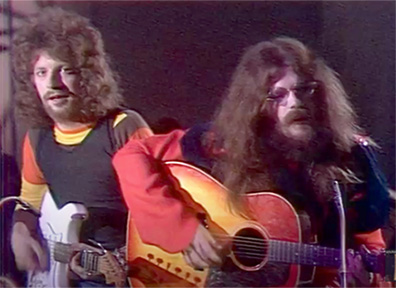
Looking On is by far the heaviest album by The Move and certainly their most experimental up to that time. The original release contained only seven tracks with each ranging from about four to ten minutes long. The best known of these is 'Brontosaurus' that came out as a single and was a hit for the band in 1970. The lesser known follow-up 'When Alice Comes Back To The Farm' was also featured on the album. Most significantly, Looking On was the first Move album to contain only all original material as composed by Roy Wood and former Idle Race front-man Jeff Lynne.
The first of the two Jeff Lynne compositions on the Looking On album titled 'What?' features the highly-melodic, haunting, and somewhat "melodramatic" quality that would become a trademark of the "ELO sound" during the 1970s. On this one, there's no mistaking that distinctive Jeff Lynne vocal that would within a few years become familiar to record buyers around the world. The second Jeff Lynne track 'Open Up Said The World At The Door', appears to include a lot more input from Roy Wood as he harmonizes on the lead vocal with Jeff and provides instrumentation such as oboe and electric sitar. This track also has an incredible drum solo, the recording of which is reversed before the song ends with a long fade-out.
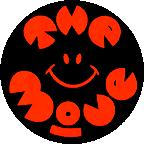
The Salvo/Fly remastered CD contains a generous helping of seven bonus tracks consisting of rough-mixes and also the non-album B-side 'Lightnin' Never Strikes Twice' as composed by Rick Price & Mike Tyler (Sheridan). Some of the rough mixes have interesting studio chatter between and during the takes that ended up getting mixed out of the final released versions. The rough mix segment of 'Feel Too Good' exposes the vocals like never before so you can hear soul/R&B singers P.P. Arnold and Doris Troy who guest on that track - they also notably provided backing vocals to the Rolling Stones classic recording 'Gimme Shelter'.
CD 'Looking On' (original stereo Fly Records album HIFLY 1):
| 1 | Looking On (Roy Wood) lead vocal by Roy |
| 2 | Turkish Tram Conductor Blues (Roy Wood) lead vocal by Roy |
| 3 | What? (Jeff Lynne) lead vocal by Jeff |
| 4 | When Alice Comes Back To The Farm (Roy Wood) with lead vocal by Roy |
| 5 | Open Up Said The World At The Door (Jeff Lynne) lead vocal by Jeff & Roy |
| 6 | Brontosaurus (Roy Wood) lead vocal by Roy |
| 7 | Feel Too Good (Roy Wood) lead vocal by Roy with backing by Jeff Lynne, P.P. Arnold and Doris Troy |
| Bonus tracks (original single B-side and rough-mixes) | |
| 8 | Lightnin' Never Strikes Twice (Rick Price & Michael Tyler) the B-side to the 1969 'Curly' single with lead vocal by Rick Price & Roy Wood |
| 9 | Looking On Part 1 take 3 rough mix |
| 10 | Looking On Part 2 take 12 rough mix |
| 11 | Turkish Tram Conductor Blues take 5 rough mix |
| 12 | Open Up Said The World At The Door take 4 rough mix |
| 13 | Feel Too Good take 11 extract rough mix |
| 14 | The Duke Of Edinburgh's Lettuce (Roy Wood/Jeff Lynne) take 2 rough mix featuring vocals by Roy, Jeff, Bev, & Rick |
Special mention should be made of the excellent re-issue artwork and packaging by Rachel Gutek that comes with all the Move remasters. The CDs come in fold-out cardboard mini-LP sleeves that reproduce the original artwork of the albums although you should be careful handling these as they may damage easily. The inside packaging includes additional high quality and previously un-published photos of the group. A nice touch on the inside of the first Move album CD package is a reproduction of one of the the original recording session tape boxes complete with biro hand-written notes and doodles!
As can be expected, a full-colour booklet is included with each of the the packages. The booklets include a well-researched write-up by well known rock biographer Mark Paytress along with extensive liner notes about the albums and individual tracks. In addition, the books include a wealth of previously-unpublished high quality colour and black & white photos of the band and assorted memorabilia. The CDs themselves are attractively printed with coloured vintage-style labels.
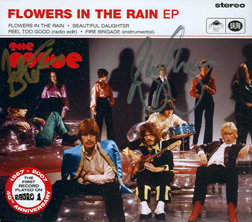
For an additional surprise bonus, the Move remasters CDs include links and passwords to Fly Records' members-only web site that you can connect to on your computer. This gives you access to an area from which you can download complete additional rare Move recordings in high-quality MP3 format that are not available on the CDs or anywhere else! A few good examples of these include a vocal-only mix of 'Night Of Fear' from 1966 (the Move's first single), and an unfinished 1967 cover of live favorite 'Price Of Love' that only exists as an instrumental backing track.
To mark the 40th anniversary of the release of The Move's 'Flowers In The Rain' single, a limited-edition four-track CD "EP" was produced by FLY/SALVO. Included on the EP is the re-mastered Flowers In The Rain, Beautiful Daughter (from the Shazam album), a radio edit of Feel Too Good from the Looking On album, and an instrumental version of Fire Brigade. This CD EP comes attractively packaged with the cover featuring a wonderful colour photo of the original line-up of the group and in its own plastic jewel case. In addition, a collectable 7 inch vinyl pressing of the EP can also be purchased from FTM that has the full-size artwork. An extremely rare 'red vinyl' version of the EP was also produced with proceeds from the sales of these going to the Carl Wayne Cancer Research Fund.
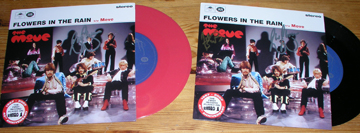
If you order direct from the FTM site, you will also receive collectable limited-edition MOVE postcards. These cards are truly collectors items themselves as printed onto good quality stock with a glossy finish. The 'Looking On' remaster will also come with limited-edition 'Move' stickers packed with your order. Another big advantage of ordering the Move CDs from the FTM site is you can save some money by having the option of getting the CDs and EPs together as a package rather than purchasing them individually (see FTM site for details).
You would think that with all these recent Move issues, there would be hardly anything left worthwhile in the vaults but far from it! There's a long way to go yet before we will hear the bottom of the barrel getting scraped as work is already in progress concerning a Move 'Box Set' of yet more rare and previously un-released recordings.
At this time Rob Caiger, in the best bloodhound tradition, is already hot on the scent of more wayward tracks to add to those already recovered. Look out for the high-quality re-issue of the Move's 'Something Else' live EP which will restore almost the complete Marquee show - in newly mixed stereo sound! plus a long-overdue definitive 'Move BBC Sessions' CD, and the legendary 'Move Live At The Fillmore' tapes at some time in the future. What then? - maybe an official Move DVD? I can hardly wait!!
For more information about these Move CDs and how to order them, visit the FTM (Face The Music) web site at www.ftmusic.com
Copyright © John R Woodhouse